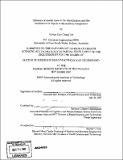| dc.contributor.advisor | Barbara G. Shinn-Cunningham. | en_US |
| dc.contributor.author | Lee, Adrian Kuo Ching | en_US |
| dc.contributor.other | Harvard University--MIT Division of Health Sciences and Technology. | en_US |
| dc.date.accessioned | 2008-11-10T19:57:43Z | |
| dc.date.available | 2008-11-10T19:57:43Z | |
| dc.date.copyright | 2007 | en_US |
| dc.date.issued | 2007 | en_US |
| dc.identifier.uri | http://dspace.mit.edu/handle/1721.1/42206 | en_US |
| dc.identifier.uri | http://hdl.handle.net/1721.1/42206 | |
| dc.description | Thesis (Sc. D.)--Harvard-MIT Division of Health Sciences and Technology, 2007. | en_US |
| dc.description | Includes bibliographical references (p. 169-182). | en_US |
| dc.description.abstract | The ability to form auditory objects is important in the natural environment where sounds arriving at our ears are a resultant of all spectro-temporal components that may have arisen from different auditory events. It has been shown that auditory spatial cues are effective for grouping acoustical energy across time or across frequency. However, little is known about the effect of spatial cues on scene analysis when more than one auditory object is being presented. In this thesis dissertation, a novel two-object paradigm was used to investigate how spatial cues influence the identification and the localization of object in the auditory foreground. Specifically, the effect of both spatial and non-spatial cues on auditory grouping and object identification was ascertained. Using an acoustic pointer and the same stimuli for the object identification task, the apparent spatial location of these objects was measured to test the hypothesis that only the spatial attributes of the components grouped to form an object influences the localization of the same object. A conceptual model was generated to highlight the role of spatial cues in object formation, and the dissociation between the auditory computation of "what" and "where" was further investigated. In current technology, object segregation presents a fundamental challenge for the hearing impaired, hearing aid design and speech recognition algorithms. It is hopeful that the findings in this dissertation will inspire new biologically-based algorithms for auditory scene analysis and in turn, influence designs in assistive hearing devices and other technological development that is dependent on multi-source segregation. | en_US |
| dc.description.statementofresponsibility | by Adrian Kuo Ching Lee. | en_US |
| dc.format.extent | 182 p. | en_US |
| dc.language.iso | eng | en_US |
| dc.publisher | Massachusetts Institute of Technology | en_US |
| dc.rights | M.I.T. theses are protected by
copyright. They may be viewed from this source for any purpose, but
reproduction or distribution in any format is prohibited without written
permission. See provided URL for inquiries about permission. | en_US |
| dc.rights.uri | http://dspace.mit.edu/handle/1721.1/42206 | en_US |
| dc.rights.uri | http://dspace.mit.edu/handle/1721.1/7582 | en_US |
| dc.subject | Harvard University--MIT Division of Health Sciences and Technology. | en_US |
| dc.title | Influence of spatial cues on the identification and the localization of objects in the auditory foreground | en_US |
| dc.type | Thesis | en_US |
| dc.description.degree | Sc.D. | en_US |
| dc.contributor.department | Harvard University--MIT Division of Health Sciences and Technology | |
| dc.identifier.oclc | 230823870 | en_US |
